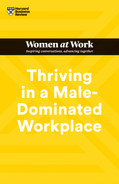Since the Women at Work podcast first launched, we’ve heard from all over the world that it has inspired discussions and listening groups. We hope that this book does the same—that you’ll want to share what you’ve learned with others. The questions in this discussion guide will help you talk about the challenges women face in the workplace and how we can work together to overcome them.
You don’t need to have read the book from start to finish to participate. To get the most out of your discussion, think about the size of your group. A big group has the advantage of spreading ideas more widely—whether throughout your organization or among your friends and peers—but might lose some of the honesty and connection a small group would have. You may want to assign someone to lead the discussion to ensure that all participants are included, especially if some attendees are joining virtually. And it’s a good idea to establish ground rules around privacy and confidentiality. Women at Work topics touch on difficult issues surrounding sexism and racism, so consider using trigger warnings.
Finally, think about what you want to accomplish in your discussion. Do you want to create a network of mutual support? Hope to disrupt the status quo? Or are you simply looking for an empathetic ear? With your goals in mind, use the questions that follow to advance the conversation about women at work.
- What are the dynamics like between men and women in your organization? Do you feel men and women are perceived as equals and given the same opportunities and assignments?
- Does your organization see itself as gender equitable? Do women have a path to leadership positions? What systems or policies are in place to ensure equitable conditions and opportunities for women? Are they effective?
- In chapter 1 Teresa Cardador describes a feeling of “outsider status” for women in male-dominated industries. Is this something you’ve experienced in your workplace? How has it changed the way you work with colleagues and team members? How has it affected your confidence and professional growth?
- Describe a time when you observed or experienced healthy competition at work and a time when you observed or experienced unhealthy competition. What differentiated these two instances? What dynamics were at play that made one healthy and one not? Were they between men, women, or a mix?
- What support exists for women in your organization? Are there mentors, sponsors, and allies available? What qualities do they have that you can recognize, and what actions are they taking—particularly men—to show that they’re trying to make the workplace better? How would you recommend making a connection with them to partner together?
- In chapter 5 we see a detailed account of the sponsorship relationship between Christina Massa and Julia González Romero. Are you a sponsor or a protégé? If so, what parts of Christina and Julia’s relationship sounded similar to your partnerships? What aspects of their arrangement do you hope to build in your professional relationships? If you’re not yet in a sponsorship relationship, what do you hope to find in a potential protégé or sponsor after seeing their example?
- Describe a time where you’ve held back because you were experiencing imposter syndrome. How did you feel in the moment, and how do you feel about it now upon reflection? If you could go back, how would you have acted differently?
- In chapter 9 Stacey Abrams and Lara Hodgson share how they leverage their differences—their gender, their race—in male-dominated spaces. Lara mentions making it her “superpower” by wearing a “statement necklace” and saying “something bold that makes the audience uncomfortable.” Where do you think this approach could work in your favor? Are there instances where you would worry this could backfire? Why?
- Do you feel comfortable promoting yourself and your accomplishments at work? Where do you struggle? What parts of this process make you feel uncomfortable? What are ways that you can overcome this feeling so self-promotion feels more natural to you?
- Share a time where someone has doubted your expertise, knowledge, or authority. Do you feel this was because of your gender, or something else? Did you respond, and if so, how? How would you navigate this type of situation in the future?
- Describe a moment when someone said something biased or sexist in your workplace. Is this common in your organization? Did you or anyone else speak up at the time? How was it handled—or was it handled at all?
- Has your boss ever said anything inappropriate or biased to you? How did you react? If you brought it up to your boss, how did the conversation go? Was your boss open to your feedback? What tips do you have for someone who faces this situation in the future?
- Do you feel your organization has a masculinity contest culture? What behaviors lead you to feel this way? Are there certain phrases that colleagues commonly use that feel especially masculine? How have you adapted your behavior to work in this type of culture? Where would you want to see the culture improve—or does it need to?
- In chapter 19 W. Brad Johnson and David G. Smith describe situational awareness, with which men perceive the gender dynamics at play. Do you feel the men in your organization are situationally aware? What can you do to help them better understand what is going on? If you’re a man, what steps can you take to increase your situational awareness?
- Throughout the book, we heard that industries and organizations need to change in order to break the systemic biases in place. Who do you feel is responsible for making sure this happens, and how do you recommend they get started? What are some steps you can take to help?
